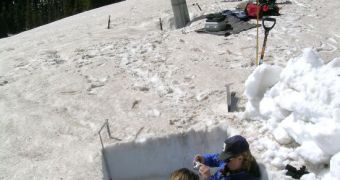According to a recent research, it would appear that the incidence of dust-on-snow events is increasing dramatically in the Colorado River Basin, with potentially devastating consequences.
The conclusion belongs to a study conducted by experts at the NASA Jet Propulsion Laboratory (JPL) in Pasadena, California, and the University of California in Los Angeles (UCLA).
A dust-on-snow event is basically when a thin layer of dust or other dark particles settles atop snow on the highest mountain peaks. The elements decrease the ice sheet's reflectivity.
Generally, white ice reflects back more than 80 percent of the sunlight hitting it. This contributes to keeping the planet cool, but also to maintaining a relatively low ice melt rate.
But the situation changes dramatically when dust is added. Because the stuff is black, it heats faster, and makes the ice underneath melt at much higher rates than usual.
This is nothing but bad news for those how are depending entirely on snowmelt for fresh water and crop irrigations. This is the case for most people living the Colorado River Basin.
“Earlier melt-out allows for an extra three weeks of snow-free conditions,” explains UCLA scientist Tom Painter, who also holds an appointment at the JPL.
“Transpired water from the uncovered vegetation during those three weeks of no-snow in the basin's mountains causes the five percent loss of water from the system,” he adds.
A paper detailing the work appears in the September 20 issue of the esteemed journal Proceedings of the National Academy of Sciences (PNAS).
“Runoff comes from the mountains in a more compressed period, which makes water management more difficult than if the water came more slowly out of the mountains,” Painter adds.
“These observations have confirmed – and most importantly quantified – what many snow and climate scientists had hypothesized but only tested in models,” adds official Jay Fein.
He is the program director in the Division of Atmospheric and Geospace Sciences at the US National Science Foundation (NSF).
According to analysts, this line of study has the potential to eventually identify the stress factors affecting water supplies.
Knowing about these risks could help experts develop better management programs for avoiding crisis situations.
“It appears that more focus on reducing dust could be effective, and in turn sustain the mountain reservoir system of snow cover, potentially increase the runoff, and counter the regional effects of climate change,” Painter concludes.

 14 DAY TRIAL //
14 DAY TRIAL //